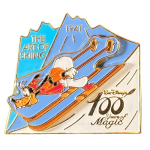The information available in this post is available as a PDF on Google drive. Remember, the internet is not forever and printing physical copies can be your friend.
 drive.google.com
drive.google.com
Cloisonne

Cloisonne is an ancient form of jewelry making and for decorating metal objects. Colored glass is crushed and fired to use as the fill. Before the start of Official Disney Pin Trading, many Disney pins were Cloisonne. Disney switched to synthetic hard enamel, presumably to increase color control, expand the color palette and control costs as the volume of pins produced increased dramatically.
Die-Cast

Molded and filled with liquid metal, instead of stamped. These pins are intended to give an obvious 3-D vs 2-D appearance. Several pre-Official Disney Pin Trading character pins, especially Mickey & Friends and Pooh & Friends, intended to be worn more as jewelry, are die-cast. There are more recent examples such as some DSSH Marquees.
Die-Struck Metal
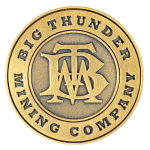
While, technically most Disney Pins start with die-struck metal, they are then normally plated, and filled with colored pigments. Sometimes Disney releases a pin without color, and are sandblasted and polished.
Domed Enamel / Photo Dome
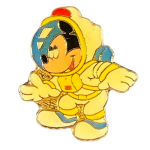
Process in which a thick layer of clear epoxy is placed over the colored elements, giving the appearance of a dome. The epoxy can discolor with age, especially over white elements. Yellow tinges, should be viewed as a sign of age, not that a pin is unauthorized.
Etched
Instead of being stamped with a die, these use an acid process to create the fine lines and recessed areas on a brass base. I tried to find a Disney example, but my collection is quite large and I’m not sure where one is! However, if you have every gotten a pin from work or an organization you are associated with, or from a local tourist attraction, you have probably come across one.
Hard Enamel

The typical process used by most pins released directly from Disney. The fill is grinded, repeatedly fired and polished to be smooth and flat. The depth is equal to or very nearly equal to the height of the metal borders that separate colors. Unlike Cloisonne, the color fill is a synthetic solid material, not glass.
Plastic
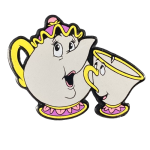
While not accepted for Cast Member trading, some Pre-Official Disney Pin Trading were made of hard plastic, while still utilizing posts and butterfly pin backs. Many of these pins were released by licensees in Europe as part of the merchandise line released for Disney Animated Movies.
Resin
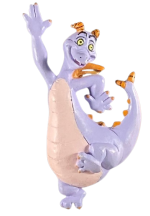
While not accepted for Cast Member trading, some brooches are made of resin and painted. Examples include a character set released in the 1990s, and Markrita boxes contained resin brooches in a hidden compartment.
Rubber

While not accepted for Cast Member trading, some Pre-Official Disney Pin Trading were made of rubber, while still utilizing posts and butterfly pin backs. Some, like this one are completely rubber, unlike newer pins that have a metal base but a rubber “Free-D” element.
Screen printed / Laser printed / Offset printed
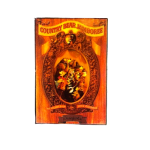
Sometimes a pin requires a lot of fine detail, and the color is printed on top of a flat metal surface. Unlike Die-Struck pins there is no metal separating the colored elements. Often, these type of pins are covered with an epoxy coating (see Domed Enamel), but not always.
Get to Know Disney Pin Finishes.pdf
 drive.google.com
drive.google.com
Get to Know: Finishes & Processes
Disney Pin Collectors who began their collection by purchasing pins at a Disney Theme Park, may be surprised to encounter pins that look different than typical hard enamel pins. Let’s go over the types of finishes and processes collectors may encounter. These are probably going to be hard to determine from photos alone, but hopefully will assist as you review the pins in your collection.
Cloisonne

Cloisonne is an ancient form of jewelry making and for decorating metal objects. Colored glass is crushed and fired to use as the fill. Before the start of Official Disney Pin Trading, many Disney pins were Cloisonne. Disney switched to synthetic hard enamel, presumably to increase color control, expand the color palette and control costs as the volume of pins produced increased dramatically.
Die-Cast

Molded and filled with liquid metal, instead of stamped. These pins are intended to give an obvious 3-D vs 2-D appearance. Several pre-Official Disney Pin Trading character pins, especially Mickey & Friends and Pooh & Friends, intended to be worn more as jewelry, are die-cast. There are more recent examples such as some DSSH Marquees.
Die-Struck Metal

While, technically most Disney Pins start with die-struck metal, they are then normally plated, and filled with colored pigments. Sometimes Disney releases a pin without color, and are sandblasted and polished.
Domed Enamel / Photo Dome

Process in which a thick layer of clear epoxy is placed over the colored elements, giving the appearance of a dome. The epoxy can discolor with age, especially over white elements. Yellow tinges, should be viewed as a sign of age, not that a pin is unauthorized.
Etched
Instead of being stamped with a die, these use an acid process to create the fine lines and recessed areas on a brass base. I tried to find a Disney example, but my collection is quite large and I’m not sure where one is! However, if you have every gotten a pin from work or an organization you are associated with, or from a local tourist attraction, you have probably come across one.
Hard Enamel

The typical process used by most pins released directly from Disney. The fill is grinded, repeatedly fired and polished to be smooth and flat. The depth is equal to or very nearly equal to the height of the metal borders that separate colors. Unlike Cloisonne, the color fill is a synthetic solid material, not glass.
Plastic

While not accepted for Cast Member trading, some Pre-Official Disney Pin Trading were made of hard plastic, while still utilizing posts and butterfly pin backs. Many of these pins were released by licensees in Europe as part of the merchandise line released for Disney Animated Movies.
Resin

While not accepted for Cast Member trading, some brooches are made of resin and painted. Examples include a character set released in the 1990s, and Markrita boxes contained resin brooches in a hidden compartment.
Rubber

While not accepted for Cast Member trading, some Pre-Official Disney Pin Trading were made of rubber, while still utilizing posts and butterfly pin backs. Some, like this one are completely rubber, unlike newer pins that have a metal base but a rubber “Free-D” element.
Screen printed / Laser printed / Offset printed

Sometimes a pin requires a lot of fine detail, and the color is printed on top of a flat metal surface. Unlike Die-Struck pins there is no metal separating the colored elements. Often, these type of pins are covered with an epoxy coating (see Domed Enamel), but not always.



